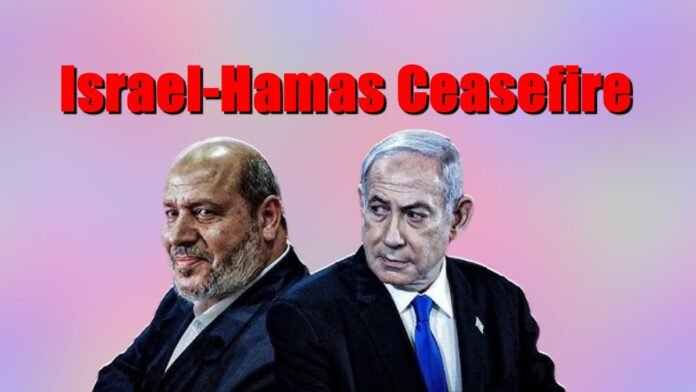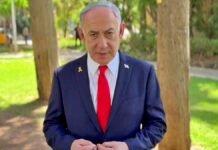
Key Points
- Israel and Hamas agree to landmark ceasefire after two years of devastating Gaza conflict
- Hostage-prisoner exchange deal: Israeli hostages freed in return for Palestinian prisoners held in Israeli jails
- Agreement marks first phase of Donald Trump’s 20-point peace proposal to end Gaza war
- Over 70,000 Palestinians killed during two-year conflict that has isolated Israel internationally
- Israel to withdraw forces from parts of Gaza as fighting comes to complete halt
- Humanitarian aid convoys with food and medicine to enter Gaza for displaced civilians
- Trump announces hostages will be released early next week
- Netanyahu faces internal coalition crisis as right-wing Minister Itamar Ben-Gvir threatens to topple government
- Disputes remain over final prisoner release list and future governance of Gaza Strip
- Celebrations erupt across Israel and Palestinian territories following announcement
Telaviv: A groundbreaking ceasefire agreement between Israel and Hamas was signed on Thursday, marking a potentially transformative moment in one of the world’s most intractable conflicts. The historic accord, brokered by US President Donald Trump, represents the first concrete step toward ending the devastating two-year war in Gaza that has claimed more than 70,000 Palestinian lives and left the region in ruins.
Terms of the Ceasefire Agreement
The comprehensive ceasefire deal centers on a carefully negotiated hostage-prisoner exchange mechanism that addresses one of the most emotionally charged aspects of the conflict. Under the terms of this agreement, all remaining Israeli hostages who were captured during Hamas’s attacks two years ago will be released and returned to their families. In exchange, Israel has committed to freeing hundreds of Palestinian prisoners currently held in Israeli detention facilities.
President Trump announced that the release of hostages would commence early next week, bringing hope to families who have endured years of uncertainty and anguish. This exchange represents not merely a humanitarian gesture but a crucial confidence-building measure between the two parties that could pave the way for more substantive peace negotiations.
The agreement mandates an immediate and complete cessation of all military operations in Gaza. Israeli Defense Forces will begin withdrawing from designated parts of the Gaza Strip, allowing Palestinian civilians to return to their communities and begin the enormous task of reconstruction. The phased withdrawal is designed to provide security guarantees to both sides while demonstrating tangible progress toward peace.
Humanitarian Relief for Gaza’s Devastated Population
One of the most critical components of the ceasefire agreement addresses the dire humanitarian crisis facing Gaza’s civilian population. The accord explicitly permits convoys of trucks carrying essential food supplies, medical equipment, and medicines to enter the territory, providing desperately needed relief to thousands of displaced Palestinians.
The humanitarian situation in Gaza has deteriorated catastrophically during the two-year conflict. Israeli military operations have destroyed vast swaths of residential neighborhoods, commercial districts, and critical infrastructure including hospitals, schools, and water treatment facilities. Tens of thousands of Palestinian families now live in makeshift camps or temporary tent settlements, lacking access to basic necessities such as clean water, adequate nutrition, and medical care.
The influx of humanitarian aid represents a lifeline for these vulnerable populations, though the scale of destruction means that reconstruction efforts will require years of sustained international support and investment. Relief organizations have welcomed the agreement, viewing it as an essential first step toward addressing Gaza’s catastrophic humanitarian needs.
International Isolation and Regional Escalation
The protracted Gaza conflict has significantly damaged Israel’s international standing and diplomatic relationships. The high Palestinian civilian death toll, widespread destruction of civilian infrastructure, and humanitarian crisis have drawn sharp criticism from the international community, including traditional allies. Multiple countries have recalled ambassadors, suspended arms exports, or imposed diplomatic sanctions on Israel during the course of the conflict.
Beyond diplomatic isolation, the Gaza war gradually escalated into a wider regional confrontation involving multiple state and non-state actors. Iran has provided support to Hamas and other Palestinian factions, while Yemen’s Houthi movement launched attacks on Israeli-linked shipping in the Red Sea. Lebanon’s Hezbollah has engaged in cross-border exchanges with Israeli forces, raising fears of a full-scale war on Israel’s northern frontier.
This ceasefire agreement, if successfully implemented, could begin to reverse Israel’s international isolation and reduce regional tensions. However, achieving lasting peace will require addressing the underlying grievances and security concerns that have fueled this conflict for generations.
Outstanding Issues and Implementation Challenges
Despite the signing of the ceasefire agreement, significant obstacles remain that could potentially derail the peace process. Palestinian sources have revealed that negotiations continue over the specific composition of the prisoner release list, with no final agreement yet reached on which individuals will be freed from Israeli custody.
The Palestinian negotiating team is insisting that the prisoner exchange include several high-profile Palestinian prisoners who have been held in Israeli jails for extended periods, some serving sentences related to security-related offenses. Additionally, Palestinians are demanding the release of hundreds of individuals who were detained during Israeli military operations conducted during the recent conflict, many of whom have not been formally charged with specific crimes.
These disputes over prisoner identities represent more than technical details; they carry profound symbolic and political significance for both communities. For Palestinians, securing the release of long-held prisoners demonstrates Hamas’s ability to negotiate effectively and achieve tangible results. For Israelis, concerns about releasing individuals viewed as security threats create domestic political pressures on the Netanyahu government.
Trump’s 20-Point Peace Framework
The ceasefire agreement represents only the initial phase of President Trump’s ambitious 20-point peace plan designed to achieve a comprehensive resolution to the Israeli-Palestinian conflict. While the immediate focus centers on ending hostilities and exchanging prisoners, the subsequent phases will address far more complex and contentious issues.
Critical questions remain unresolved regarding the future governance structure of Gaza following the war’s conclusion. The international community and regional powers must determine which entity or coalition will administer the territory, provide security, deliver government services, and oversee reconstruction efforts. Various proposals have been discussed, including Palestinian Authority administration, international peacekeeping forces, or some form of joint governance arrangement.
Equally challenging is determining Hamas’s future role in Gaza and Palestinian politics more broadly. Israel has consistently demanded Hamas’s complete disarmament as a precondition for any lasting peace settlement, arguing that the group’s military capabilities pose an ongoing security threat. However, Hamas has thus far refused to accept disarmament conditions, viewing its armed wing as essential for Palestinian resistance and political leverage.
These fundamental disagreements over governance and security arrangements could potentially undermine the ceasefire if not addressed through sustained diplomatic engagement and creative compromise solutions that address both sides’ core concerns.
Netanyahu’s Coalition Crisis
Israeli Prime Minister Benjamin Netanyahu confronts a severe political crisis within his own governing coalition as a direct result of the ceasefire agreement. The deal has exposed deep ideological divisions within Netanyahu’s right-wing coalition, threatening the government’s survival and potentially forcing new elections.
National Security Minister Itamar Ben-Gvir, representing the far-right nationalist faction of the coalition, has issued an ultimatum warning that he will vote to bring down the government if Hamas is not completely eliminated as a military and political force. Ben-Gvir has announced his intention to vote against the proposed ceasefire agreement, viewing it as a capitulation to terrorism and a betrayal of Israel’s security interests.
Ben-Gvir’s opposition reflects broader concerns among Israeli right-wing parties that the ceasefire agreement fails to achieve Israel’s stated war objectives of destroying Hamas’s military capabilities and ending its governance of Gaza. These coalition partners argue that agreeing to a ceasefire without Hamas’s complete defeat represents a strategic failure that will embolden Israel’s enemies and compromise long-term security.
Netanyahu must navigate this internal political minefield while simultaneously managing complex ceasefire negotiations, addressing security concerns, and responding to public pressure for the hostages’ safe return. His political survival may depend on his ability to demonstrate that the ceasefire serves Israel’s security interests while delivering tangible results such as the hostages’ release.
Public Reactions and Celebrations
Despite political turbulence at the leadership level, the ceasefire announcement has been met with overwhelming relief and jubilation among ordinary Israelis and Palestinians. Across Israel, communities erupted in spontaneous celebrations as news of the agreement spread, with families of hostages expressing profound gratitude for the prospect of their loved ones’ imminent return.
The emotional toll of the two-year conflict has been enormous for Israeli society, with the hostages’ plight generating constant national anguish and political pressure on the government to secure their release. The announcement that hostages will return home early next week has provided these families with the first real hope they have experienced since the conflict began.
In Palestinian territories, the ceasefire has likewise been greeted with celebrations tempered by the grief of massive casualties and destruction. Palestinian communities view the agreement as an opportunity to begin rebuilding shattered lives, reconnect with displaced family members, and access desperately needed humanitarian assistance. The prospect of imprisoned family members returning home has generated particular joy among Palestinian families affected by Israel’s detention policies.
The path forward remains uncertain and fraught with challenges. Successfully implementing this ceasefire agreement will require sustained commitment from all parties, continued international diplomatic support, and willingness to make difficult compromises on contentious issues. However, the signing of this historic accord represents genuine progress toward ending a conflict that has caused immeasurable suffering and offers hope that lasting peace may yet be achievable.




















































